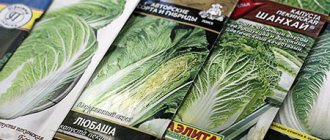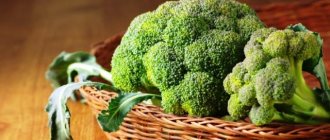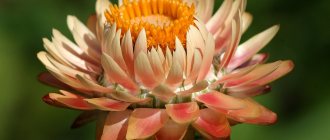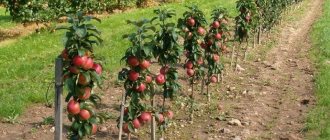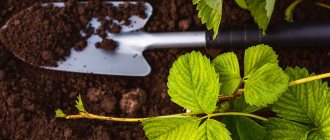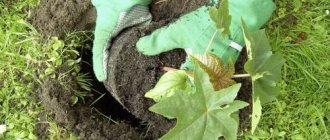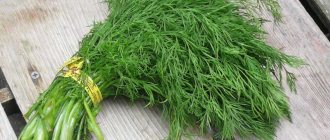We continue our sowing work. We plant the beds one by one, choosing the right time and conditions for growing a particular crop. And now it's time to sow lettuce. When is the time to plant it? What conditions are needed? What results will growing seedlings give? I will try to answer all these questions. I’ll also tell you a little about the varieties and about planting crops for the winter.
But I want to start with motivation! We are accustomed to seeing only an attractive appearance in this plant. Indeed, green leaves decorate the dish. But the main advantage of the plant is its health benefits. Thanks to a huge amount of vitamins, microelements and antioxidants, it is good for skin, hair, and nails.
The plant has a beneficial effect on the digestive system, acts as a preventive measure for many heart diseases and cancer, strengthens the immune system, and eliminates problems with the body’s absorption of vitamins. It is useful for those with diabetes. It reduces appetite and calms the nerves, etc., etc. At the same time, the leaves themselves are low in calories. Great for those on diets. In addition, it is very tasty, especially with radishes. By the way, are you planting radishes correctly?
And although lettuce is more familiar to us as one of the ingredients of beautiful, tasty and healthy dishes, there is another use for this plant. Masks based on it have a beneficial effect on the quality of our skin, rejuvenate it, enrich it with vitamins and moisturize it. I think we now have a lot of reasons to want to grow plants on our property.
Planting and caring for lettuce
- Planting: sowing seeds of early-ripening varieties in open ground - from April to May, mid-ripening and late - from April to mid-June. You can sow early varieties before winter - at the end of October or at the beginning of November. Sowing seeds for seedlings can begin in April, and seedlings are planted in open ground in May. When growing lettuce at home, sowing is done at any time.
- Lighting: bright sunlight or bright diffused light.
- Soil: loose, nutritious, humus, moderately moist - chernozems, loams, carbonate soils with pH 6.0-7.0.
- Watering: usually once a week in the mornings or evenings. From the moment the heads form, watering is reduced. In extreme heat, water the salad at night.
- Feeding: not needed. Fertilizers are applied to the soil before sowing or planting seedlings.
- Reproduction: seed.
- Pests: lettuce flies, lettuce stem aphids, white-striped fillies and slugs.
- Diseases: white and gray rot, peronosporosis, powdery mildew and viral mosaic.
Read more about growing lettuce below.
Rules for caring for seedlings
The rules are quite simple, but it is important to follow them in order to get a rich harvest and not spoil the taste of the salad. Since this is a moisture-loving crop, at first the seedlings are watered once every 2 days, and the air temperature should be around +16-20 °C
It is important to avoid dry indoor air, so additional irrigation with warm water will not be superfluous.
In order for the bushes to increase green mass, once a week they are fertilized with complex additives, preferably in the form of granules. Since lettuce quickly absorbs nitrates, becoming unfit for consumption, it is advisable to avoid excessive use of nitrogen fertilizers by replacing them with organic matter.
To moisten and water the salad, use settled water at room temperature.
Lettuce plant - description
lettuce plant which would be more correctly called lettuce, is a herbaceous plant of the Lettuce genus of the Asteraceae family. This crop is represented by annual, biennial and perennial varieties. The name of the genus comes from the Latin word lac, which means “milk” - the plant contains milky juice. There are several varieties of lettuce - leaf, half-head and head, as well as romaine (Roman). All these forms are equally popular in amateur gardening.
First, the lettuce develops basal leaves, and only then does a highly branched flowering stem appear, reaching a height of 60 to 120 cm. Yellowish-green, sometimes red, lettuce leaves form a basal rosette. They are obovate, sessile, horizontal, large, entire, jagged or rugged, smooth, wrinkled, curly or corrugated.
In head lettuce, the leaves close together to form a round or flat-round head. On the underside of the leaves along the midrib are bristles. Lettuce inflorescences are small cylindrical, pitcher-shaped heads, consisting of small reed bisexual yellowish flowers, which are collected in large numbers into panicles. The fruit of lettuce is an achene.
- Currants: growing in the garden, types and varieties
The origin of the lettuce is unknown for certain, but it is suggested that it originated from compass lettuce, which grows wild in Western Asia, North Africa, Central Asia, Southern and Western Europe. The herb lettuce was introduced into culture long before our era: there is evidence that lettuce was cultivated in the ancient states of China, Greece, Rome and Egypt. In Europe, it began to be grown in the 16th century.
Lettuce is a cold-resistant, light- and moisture-loving crop. Fresh lettuce leaves, which contain large amounts of vitamins and minerals, are eaten. However, as the stem begins to grow, the leaves of the plant acquire a bitter taste and become unsuitable for food. Not everyone knows the beneficial properties of lettuce, which we will introduce you to, as well as the contraindications of lettuce, which, fortunately, are very few.
Features of the salad
The correct name for the herbaceous plant lettuce is lettuce; it is considered a member of the genus Lettuce of the Asteraceae family. Such a plant can be an annual, biennial or perennial. The name of this genus comes from the Latin word lac, which translates as “milk”; the fact is that the plant contains milky juice. Lettuce comes in several varieties: half-head, leaf, head, and romaine. Each of these varieties is very popular among gardeners in all countries.
First of all, the lettuce bush grows basal leaf plates, and only then does it form a flowering stem, which is highly branched, its height can vary from 0.6 to 1.2 m. The basal rosette is formed from leaf plates of greenish-yellow, less often red color . Large sessile horizontal leaf blades have an obovate shape, a jagged, solid or jagged edge, as well as a wrinkled, corrugated, smooth or curly surface. In cabbage varieties, the leaf blades close together, forming a flat-round or rounded head. On the reverse surface there are bristles on the central vein. The inflorescence is a small cylindrical head, pitcher-shaped; it consists of small bisexual reed flowers of a pale yellow color, which in turn are collected in large quantities into paniculate inflorescences. The fruit is an achene.
To date, scientists have not yet established exactly how the salad originated. However, there is an opinion that it originated from compass lettuce, which is naturally found in North Africa, Western Asia, Central Asia, and also in Western and Southern Europe. Man began to cultivate lettuce even before our era. There is evidence that such a plant was grown in the ancient states of Greece, Egypt, China and Rome. Lettuce began to be cultivated in Europe in the 16th century.
This culture is resistant to cold, as well as moisture- and light-loving. For food they use fresh leaves, which contain a lot of minerals and vitamins. But as soon as the stem begins to grow, the taste of the leaf blades becomes bitter, and they can no longer be eaten.
Sowing lettuce seedlings
When to sow lettuce seedlings
Through seedlings, lettuce is grown for early production or in late cold spring conditions. Lettuce in the Moscow region or other areas of the middle zone can be sown directly into the ground, but in more northern areas it is better to use the seedling method for growing lettuce. You can sow lettuce in boxes, or in protected soil under a film. Lettuce seeds are sown for seedlings 30-35 days before planting the seedlings in open ground. For sowing, it is best to use pelleted seeds - they are more convenient to sow and they have a high ability to germinate. If you have regular seeds, mix them with sand to make your work easier.
Growing lettuce from seeds
To prepare the substrate, you need to add two parts of high-quality humus soil to the sand and peat, taken one part at a time, and mix well. Although it is easier to purchase “Universal”, “Vegetable” or “Biosoil” soil in the store. Boxes and containers can be used as containers, but it is better to use pressed peat cubes with a side of 4-5 cm. The seeds are pickled for 2-3 hours in a pink solution of potassium permanganate and scattered over the surface without covering them.
If a box is used for sowing, the seeds are sown in grooves no more than 1 cm deep. The distance between the rows should be 5 cm, if you later pick the seedlings, and if you decide to do without picking, then the interval should be at least 10 cm. Sowing Water generously but carefully and place under film. It is better to keep them in a bright place at a temperature of 18-21 ºC.
Shoots may appear as early as the third or fourth day, and as soon as this happens, the temperature is lowered by 3-4 degrees, otherwise the seedlings may stretch out. When the seedlings develop 1-2 true leaves, they are pruned if necessary. Seedlings are planted in open ground at the 3-4 leaf development stage after a two-week hardening of the seedlings, which consists of spending some time daily in the fresh air, and the duration of these sessions is gradually increased until the seedlings can spend the whole day in the yard.
Growing lettuce at home does not require hardening procedures.
How to grow lettuce
Lettuce can be planted in open ground, in greenhouses and even in an apartment, using any suitable sized boxes or pots.
Salad on the windowsill
The container for growing lettuce can be of any height, depending on the type of plant, from 10 to 30 cm. Drainage holes are required in the bottom through which excess water will drain into the tray after watering. A layer of 2–5 cm of expanded clay or small pebbles is placed at the bottom. Homemade salads grow in almost any soil, but it is better to purchase universal soil at the store.
The seeds are sown to a depth of about 1 cm, carefully watered, cover the box with glass and keep in a warm place. Shoots will appear in warmth in 4–5 days, at 15 oC a little later. The box should be immediately placed on a lighted window sill, the glass should be removed. Tender shoots have to be protected from direct sunlight, but they soon get used to it, and there are no problems with growing lettuce at home.
Lettuce grows in an apartment at any temperature, but if in winter the temperature outside the window is less than 17 °C, you need to find a warmer place, but still well lit. For most varieties, it is imperative to equip the backlight with fluorescent lamps. They are hung 50 cm from the plants and turned on so that the daylight hours are 12–14 hours. In addition to watering the plants, which is carried out once every 2-3 days, and sometimes more often, the air in the apartment in winter also has to be humidified.
For home growing, lettuce is one of the most traditional crops.
Plants in pots are thinned out on time: after a week, 4–5 cm are left between them, and then - depending on the characteristics of the variety. At home, they usually do not wait for the lettuce to fully ripen, picking off the leaves a little every day. But with the appearance of flower shoots, the plants are removed and new ones are planted.
Lettuce in open ground
Growing lettuce in open ground is the most traditional and is carried out everywhere. It can be sown on any free space in the beds at any time, from April to August. Some varieties grow in partial shade, but for most, sun, fertile soil and the absence of weeds are important. The bed must be kept constantly moist but clean. Any beginning summer resident can grow lettuce in the garden.
Growing lettuce in a greenhouse
Precious greenhouse space is occupied for salad only by gardeners living in the northern regions, and those who want to receive their produce very early. You can sow seeds in a heated greenhouse even in winter; in a regular film greenhouse in the middle zone - in the middle or end of March.
Seeds can germinate already at 5 ° C, seedlings can tolerate light frosts.
Greenhouse cultivation is the most difficult: in the fall you need to not only dig up the bed, but also disinfect the soil, and in early spring create conditions so that the soil in the greenhouse bed warms up more quickly: pour boiling water over it, cover it with film. And even during the growth of lettuce (end of March - April), cold snaps are possible in a regular greenhouse, so you will have to monitor the plantings daily.
Greenhouse growing of lettuce is more often used industrially.
If, on the contrary, early heat sets in, the greenhouse should be constantly ventilated. The lettuce does not do well at temperatures close to 30 ° C: it tries to throw away the flower shoots as quickly as possible, and the taste of the leaves deteriorates significantly, they become dry and bitter.
Growing lettuce at home
How to grow homemade lettuce
Growing lettuce in an apartment can be done all year round. Lettuce is planted in boxes or pots with a capacity of 1-2 liters, which are placed on bright, sunny windowsills in the spring. In winter, most likely, you will have to provide the plant with additional lighting with fluorescent lamps or phytolamps in order to increase the length of daylight by 2-3 hours.
As a substrate, you can use the mixtures we have already mentioned, or you can make it up from one part of vermicompost and two parts of coconut fiber. Pickled, as mentioned, the seeds are immersed in a moist substrate, laid out in pots on top of the drainage layer, by 5-10 mm, after which the crops are watered, covered with polyethylene and placed in a dark place. As soon as shoots appear after 3-5 days, the film is removed and the crops are transferred to light. You can eat lettuce when it develops 5-10 leaves. Do not wash cut lettuce if you plan to store it because it will rot.
Watering the lettuce
Lettuce at home needs regular watering once every two or three days; it is especially important to water the lettuce in hot weather, since drying out the substrate accelerates the formation of flower shoots and, accordingly, the appearance of a bitter taste in the leaves. In general, the optimal temperature for growing seedlings is 16-20 ºC, although on the loggia they feel great at a temperature of 6-7 ºC.
More dangerous than coolness is elevated temperature and dry air for salad, so fresh young greens must be sprayed daily with a spray bottle. You need to water and spray the salad in the pot with settled water at room temperature.
Feeding lettuce
Intensive growth of lettuce is possible only with adequate nutrition, so it is advisable to add liquid complex fertilizer to the substrate every week. But since lettuce has the ability to accumulate nitrates, the amount of nitrogen introduced needs to be controlled, and even better, feed homemade lettuce with organic matter, for example, an aqueous solution of mullein in a ratio of 1:10.
Growing May King Lettuce from Seeds. When to plant in the ground
The mid-early variety May King produces a harvest already on the 60-65th day. It can easily withstand sub-zero temperatures down to 5⁰. It has large rosettes, reaching up to 25cm in diameter. It is important to know that if the air temperature is above 20⁰, the plant’s yield may fall.
Features of growing lettuce:
- You should choose a sunny, slightly shaded place for growing; without drafts.
- You can also plant them in the aisles where carrots, potatoes, cucumbers, zucchini or onions grow.
- May King prefers fertile, non-acidic soils.
- Before planting, the soil should be fertilized with urea (20g) and saltpeter (30g) per 1 sq.m.
- The time for sowing seeds is April-May.
- Planted at a depth of 1-2cm, the distance between seeds is 20cm, between rows - 50cm.
- In growing it is important:
- Thin out the planting so that the plants can develop;
- Water at least once a week (even more often in dry weather);
- Loosen the soil and remove weeds;
- After watering and in hot weather, mulch the soil around the plant.
The crop should be stored at sub-zero temperatures. This way it stays fresh and attractive for a long time.
Growing lettuce in open ground
Planting lettuce in the ground
Since lettuce is a cold-resistant crop, it can be sown in the ground before winter - at the end of October or at the beginning of November. In the spring, early-ripening varieties of lettuce are sown from April to May, mid-ripening and late varieties - from April to mid-June. If you want to have fresh lettuce all summer, you can sow it multiple times every 7-10 days until mid-August.
- Potatoes: planting tubers in spring - how and when
The conditions for growing lettuce require placing the bed in an open, sunny place. Sow lettuce in loose, nutritious soil with a sufficient amount of organic matter and microelements. The acid reaction of the soil should be slightly alkaline or acidic - from 6.0 to 7.0 pH. Only heavy clay soils are not suitable for the plant, but lettuce grows normally in black soil, loam, carbonate soils and sand.
It is good if, before the salad, early cabbage, zucchini, potatoes or cucumbers were cultivated on the plot, for which fertilizers were added to the soil, and next to the lettuce it is better to grow all types of cabbage, radishes and radishes - the cruciferous flea beetle, which harms cabbage crops, really does not like lettuce. Lettuce is also a good neighbor for plants such as strawberries, peas, tomatoes and spinach. The salad itself benefits from its proximity to onions, which repel aphids from it. Lettuce is grown in one area at least at two-year intervals.
Prepare a bed for salad in advance: dig it up, adding compost or rotted manure at the rate of 1 bucket of organic matter per m² of area. In the spring, when loosening before planting, add 1 tablespoon of superphosphate, 1 teaspoon of potassium sulfate and 1-2 tablespoons of Mortar per m² into the soil. On acidic soils, instead of Mortar, use Nitrophoska in the same amount, always adding 200 g of dolomite flour per unit area. Sow seeds mixed with sand in a ratio of 1:0.5 into grooves 5-10 mm deep, made in moist soil at a distance of 15-20 cm from each other.
Seeds germinate at a temperature of 5 ºC, but keep in mind that at 20 ºC lettuce germinates worse. When the seedlings begin to rise en masse, they need to be thinned out so that between the seedlings there is ultimately an interval of 6-8 cm for leaf varieties and 10-15 for cabbage varieties. It is better to carry out thinning in two stages.
If you prefer to grow lettuce using seedlings, then plant seedlings of compact early-ripening varieties according to the 25x25 cm pattern, and large lettuce - 35x35 cm. Planting is carried out in moist soil. The root collar of seedlings should be at surface level or slightly above.
How to grow lettuce in the ground
Growing lettuce in open ground requires, first of all, regular watering, loosening the soil and weeding. Try to loosen the soil after each watering or rain and promptly remove weeds from the area.
Watering the lettuce
Lettuce in open ground is watered once a week, in the morning or evening. For leafy varieties, it is better to use the sprinkling method, and head lettuce is moistened by watering the soil along the rows. From the moment the lettuce begins to form heads, watering should be reduced so as not to provoke the development of putrefactive phenomena. In order to prevent internal necrosis of lettuce, in extreme heat it is better to water at night. In general, the need for watering is determined primarily by weather conditions.
Feeding lettuce
If the soil was well fertilized before sowing, there is no need to feed lettuce varieties in the future. But if there are not enough nutrients in the soil to produce crisp lettuce, you will need to add nitrogen, phosphorus, potassium, calcium and magnesium to the soil. Head lettuce, since it takes longer to ripen than leaf lettuce, needs one or two feedings. As fertilizers, you can add fermented infusion of grass, mullein diluted with water (1 part fertilizer and 10 parts water), bird droppings diluted with water in a ratio of 1:20, or vermicompost. Fertilizing is usually combined with watering the lettuce.
What to plant after lettuce
Next year, it is best to plant peppers and tomatoes in the area where you grew lettuce.
Technology and sowing methods
There are 4 options for sowing lettuce seeds to grow seedlings. Each has its own characteristics and nuances that need to be remembered.
In the open ground
A few weeks before planting the seeds, humus is added to the soil and dug up. Additionally, it is recommended to add superphosphate or potassium salt, which will saturate the soil with the necessary nutrients.
If the soil is severely depleted, it is also recommended to add wood ash, any organic matter and perlite sand, adding them when digging up the area.
It is also important to carry out disinfection, which will allow you to get the maximum yield and reduce the risk of pest infection.
There are two methods:
- water the soil with a weak solution of potassium permanganate;
- pour boiling water over it.
Sowing lettuce seeds in open ground
Immediately before planting, the soil is leveled, large lumps of earth are broken up - the soil should be loose, allowing air to pass through. If the soil is lumpy, too clayey and heavy, it is diluted with peat or clean river sand.
It is important to devote time to preparing the seed itself. The seeds need to be sorted and calibrated, removing the smallest and non-viable ones that have damage or black spots on the surface. If you have no experience in performing high-quality calibration, the following recommendation will help:
- Make a saline solution (1 tablespoon of salt per 1 liter of water).
- Soak the seeds in it for 15 minutes.
- Those grains that float to the surface are removed because they are defective and will not sprout.
- The rest are washed with clean water, dried on a paper napkin and disinfected for safety in a solution of potassium permanganate for 15 minutes.
In the greenhouse
In this case, it is also necessary to treat the seeds in a solution of potassium permanganate. One of the main recommendations when growing lettuce is to use a suitable soil mixture. You can purchase it yourself, but many gardeners make it themselves.
To do this you will need:
- 2 parts of high quality humus;
- 1 part each of sand (pure river) and peat.
If at first the grains are planted in individual cups, no more than 3 seeds can be placed in each container.
When planting lettuce in boxes, first make small holes in the soil at a distance of 10 cm from each other, then place a seed in each hole. Regardless of the method chosen, seeds can be buried in the soil to a depth of no more than 1 cm.
When planting in a common container, it is important to remember a number of features:
- if in the future it is planned to pick seedlings, then there should be at least 5-7 cm between the rows;
- It is recommended to cover containers with seeds before the first shoots appear with film or glass, which are immediately removed as soon as the young plants hatch;
- if picking is planned, it is carried out after the seedlings have formed at least 2 true leaves.
For hydroponics
A fairly popular way to grow lettuce, since this crop responds well to hydroponics and is moisture-loving. The only caveat is the need to create special growing conditions, which include:
- in the growing chamber the humidity must be at least 100%, the soil temperature at the time of seed germination is at least +18 °C;
- when the seedlings hatch, the first true leaves appear on them, the temperature should remain at +16 °C-18 °C for two weeks;
- if they continue to grow lettuce using this method, they need to organize a greater temperature spread: at night the temperature should be at +16 °C, during the day at least +18 °C, not more than +20 °C; The humidity should be 60-80%.
Growing lettuce on a windowsill
One of the best growing options, and in this case you can harvest lettuce all year round. To plant seeds, it is better to use pots or boxes with a volume of up to 2 liters.
In the spring they are placed on a lighted windowsill, but in winter they will have to be provided with additional lighting using phytolamps or fluorescent lamps.
To grow lettuce on a windowsill, it is better to use a substrate that consists of:
- 2 parts coconut fiber;
- 1 part vermicompost.
Instructions:
- Take a container and place a drainage layer on the bottom.
- Fill the box with moist soil.
- Plant the seeds 1 cm deep.
- Spray the soil with a spray bottle, cover it with film or glass, and put it in a dark place.
- After a few days, the first seedlings will appear, after which you need to remove the coverings and move the container itself to a lighted place.
The first shoots will appear 2-4 days after sowing the seeds. The first few days of planting are systematically watered every day. It is especially important to spray seedlings on hot days - if the soil is too dry, this will lead to bolting, which can cause the lettuce leaves to become bitter.
The temperature should be around +16-20 °C, but most varieties of lettuce grow well at cool temperatures (most importantly, not lower than +10 °C). The main thing is to regularly spray the plantings, since excessively dry air also harms this plant.
It is also important not to forget about fertilizers. Once a week, complex additives are added to the soil mixture, preferably in liquid form. They can be combined with organic fertilizers. A mullein solution is ideal, which is prepared in a ratio of 1 to 10.
Sowing seeds under glass
In this case, the seeds are planted in small cups filled with a mixture of soil and compost, 1-2 seeds are placed in each container, watered thoroughly and covered with glass on top.
When the seeds sprout, the weakest seedlings are removed. After 2-3 days, when the seedlings have become stronger, the glass is removed and the containers with lettuce are taken out onto the balcony or outside so that the young plants get used to the environment. When the seedlings grow and become stronger, they can be planted in open ground.
Sowing of early varieties is carried out in April–May, late-ripening and mid-ripening varieties are sown from April to the second half of June
Pests and diseases of lettuce
Lettuce diseases
The most harmful diseases of lettuce are white and gray rot, downy mildew, powdery mildew and viral mosaic. The difficulty is that lettuce diseases cannot be controlled with chemicals, since the leaves of the plant accumulate not only nitrates from nitrogen fertilizers, but also fungicides.
Gray rot of lettuce, caused by the fungus botrytis, affects the stems and leaves: necrotic brown spots appear on them, which gradually spread from the bottom to the top of the plant. Cloudy weather and high air humidity favor the development of gray rot.
Methods of protection: The most important method of preventing the disease is crop rotation. Keeping the area clean and immediately removing affected leaves and plant debris at the end of the season will help protect the lettuce from gray rot. In addition, there are lettuce varieties that are not so susceptible to gray rot, for example, Moscow Greenhouse, Khrustalny or Maysky.
White rot affects the above-ground organs of lettuce. The infection penetrates leaves that are close to the ground or lying on it, then the disease penetrates the stem through the petioles and forms light, watery spots on it. The affected tissues are covered with a flaky white coating of mycelium.
Methods of protection: in the fight against white rot, a mandatory condition is the rotation of crops, timely removal of affected leaves and specimens. In autumn, it is recommended to carry out deep plowing or removal of plant residues. Do not grow lettuce in heavy acidic soils and control the amount of nitrogen in the soil.
- Turnips: growing from seeds in the garden, varieties
Downy mildew, or downy mildew, also affects the ground organs of lettuce: almost yellow, blurry or angular spots appear on the upper side of the leaves, while on the lower side the leaves become covered with a white coating. As the disease progresses, the spots turn brown and the diseased leaves dry out. The disease progresses in conditions of high air humidity and the presence of drip moisture.
Methods of protection: it is necessary to strictly observe the rotation of crops on the site, sow healthy seeds. If there are doubts about the quality of the seed, etch it in an eighty percent TMTD solution. Do not thicken the crops - follow planting patterns for both leaf and head varieties of lettuce.
Edge burn - with this disease, rot gradually takes over the entire plant, and it dies. Too much nutrients in the soil contributes to the development of the disease.
Methods of protection: compliance with crop rotation, balanced application of fertilizers, especially nitrogen, to the soil, regular watering, timely removal and destruction of diseased specimens and plant debris from the site at the end of the season.
Powdery mildew affects the stems, heads and leaves of lettuce - a white powdery coating appears on them, the growth and development of the plant slows down. Lettuce seeds suffer the most during the flowering and seed ripening stages. Powdery mildew progresses during periods of sharp fluctuations in day and night temperatures.
Methods of protection: the disease can be prevented by observing crop rotation, removing diseased leaves and heads of cabbage during the growing season and plant debris after its end.
Lettuce pests
Among lettuce pests, the lettuce fly, lettuce stem aphid, white-striped fly and slugs are especially dangerous.
The lettuce fly is an insect 7-8 mm long. Females are ash-gray with wide-set red eyes, while males have a black velvet back. Flies damage the seed plants of the plant - they lay eggs on the inflorescences, and the larvae that emerge from them destroy the seeds. Damaged inflorescences do not open and darken.
Methods of protection: as soon as the first larvae appear, the plants are treated with Phosfamide in strict accordance with the instructions. Inflorescences damaged by the pest should be cut off and destroyed.
The stem lettuce aphid is a very common pest. Wingless insects are from 1 to 2.5 mm in length, winged ones are slightly smaller - up to 2 mm. These are sucking pests of grayish-green or dark gray color that colonize flowers, stems and leaves of lettuce. Organs damaged by aphids become discolored, curl, and the color of the lower leaves becomes mosaic. As a result, plants lag behind in growth and development. In autumn, lettuce aphids move to currants.
Methods of protection: Treating its leaves with infusions of onion peels, dandelion leaves or green potato tops will help you protect lettuce from aphids.
The white-striped, or slender filly, is a polyphagous pest of locusts of grayish-yellow, green or brown color. The length of the filly is from 13 to 21 mm. This is a chewing pest that damages the leaves and stems of lettuce.
Methods of protection: to prevent the appearance of these insects, you need to remove perennial weeds, especially wheatgrass, from the site. After harvesting the lettuce, spray the plant debris and soil well with Karbofos solution, and the next day remove the residue from the site.
Naked slugs also often damage tender lettuce leaves by making large holes in them. Gastropods are most active in the evening and at night, and during the day they lie down in cool dampness - among the leaves, in the shade of plants.
Methods of protection: cans of beer are placed on the site, and when the slugs crawl in to drink, they are collected and destroyed.
How and when to plant lettuce in a greenhouse without heating in early spring
The greenhouse helps to cultivate the plant in regions with harsh climates and to obtain early results. Since the crop is considered cold-resistant, it can be sown even in greenhouses without heating. Leaf and cabbage varieties are most suitable for this. Only leafy ones are planted directly into the soil. Headed - into seedling containers.
When can you start planting lettuce in greenhouses? The optimal sowing time in a greenhouse without heating is from mid-March to mid-April. The soil will help determine when exactly it is time to sow. It shouldn't be frozen. If necessary, it can be warmed up by covering it with straw or film.
How to sow lettuce in greenhouses:
- The day before sowing, the seeds are poured with warm water to swell.
- Prepare grooves on the bed 3cm deep, the distance between the grooves is 20-25cm.
- The grooves are filled with water.
- The seeds are arranged into grooves at a distance of 10-20 cm (depending on the variety).
- Cover with a 1cm layer of earth.
If you provide good refreshment and timely watering, the lettuce will quickly germinate and produce a good harvest.
Types and varieties of lettuce
Lettuce is a species of the genus Lettuce, therefore, when they write “types of lettuce,” they most likely mean four of its varieties - leaf, half-head, head and the so-called romaine, or Roman.
Leaf salad
They are used without pulling out or digging up the plant, but by tearing off leaves from it - large and whole (oblong, fan-shaped or triangular) or cut-out (dissected or oak-leaved). The most famous varieties of lettuce:
- Critz is a heat-resistant, early-ripening lettuce for protected and open ground, ripening in 40-45 days. It has thin leaves of a light green and yellowish tint. The weight of one plant is about 250 g;
- Emerald is a heat- and stem-resistant mid-season variety with dark green obovate, finely blistered leaves of excellent taste. The plant weighs about 60 g and does not age for a long time on the vine;
- Ballet is a variety resistant to bolting and lack of light for growing in spring and winter in protected ground, and in summer in open ground. The leaves are large, dark green, crisp, fan-shaped with a scalloped edge. The weight of one plant is from 300 to 600 g;
- Zabava is a mid-season variety resistant to disease and stemming with bright red, large leaves with an oily texture. The weight of the socket is about 200 g;
- Sandwich is an early variety with tender and crisp leaves of light green color with wavy edges. The average weight of one plant is about 180 g. The variety is ideal for making sandwiches and salads;
- Moscow greenhouse is an early ripening variety for protected soil, ripening in 30-40 days, with large, sweetish, juicy and delicate light green leaves up to 18 cm long. The rosette weight is from 100 to 200 g. The advantage of the variety is also that its leaves remain fresh for a long time and do not acquire a bitter taste.
In addition to those described, leaf varieties such as Tornado, Roblen, Dubachek, Dubrava, Lollo Rossa, Lollo San, Lollo Biondo, Lakomka, Royal, Kitezh, Crispy Vitamin and others are popular.
Half head lettuce
It looks like ordinary leaf lettuce, and its leaves are collected in small but open heads. The most famous varieties of this type of lettuce are:
- Odessa kucheryavets is a mid-season variety resistant to flowering, forming a loose rosette with a diameter of 24-32 cm and weighing no more than 200 g. The leaves of plants of this variety are green, fan-shaped, with a corrugated edge, crispy, of excellent taste;
- Eurydice is a mid-season variety with a semi-raised compact rosette about 35 cm high and about 33 cm in diameter. The leaves are large, dark green, bubbly with a wavy edge, crispy, of excellent taste;
- Festival is a mid-season variety that ripens in about 70 days. It has a large round rosette weighing up to 150 g, consisting of juicy light green leaves of excellent taste;
- Berlin yellow is also a mid-season variety with a rounded rosette with a diameter of up to 30 cm and a weight of up to 200 g, consisting of yellowish leaves;
- Kucheryavets Gribovsky is a disease-resistant mid-early variety with a loose rosette weighing from 250 to 470 g. The leaves are bright green, large, fan-shaped with a finely corrugated edge, crispy and juicy, of excellent taste.
Half-headed varieties such as Kado, Stone Heads, Grand Rapids, Azart, Admiral and others are also popular.
Head lettuce
In appearance it resembles dense heads of cabbage. The scientific name for creepheads lettuce is crispheads because the leaves of this lettuce actually have a lot of crunch. This variety was bred by California farmers back in the 20s of the last century. Types of head lettuce:
- Iceberg is a high-yielding variety that is not prone to bolting, ripening in 75-90 days, with pleasant-tasting, bubbly leaves with wavy edges that retain freshness for a long time. The weight of heads of cabbage of this variety is 300-600 g;
- Great Lakes is a bloom- and scorch-resistant, crisp, late-ripening, high-yielding variety that matures in 85 days. It has a large round head with a closed top, consisting of dark green leaves, shaped like oak leaves;
- Attraction is a productive mid-season variety with a high rosette consisting of large, light green, slightly wavy along the edges, oily, triangular-shaped leaves. Weight of one head is 230-260 g;
- Four seasons - mid-season variety for open and protected ground with medium-sized heads. The outer leaves are red-bronze, while the inner leaves are yellow-green. The texture of the leaves is delicate and oily, the taste is excellent;
- Design - a high-yielding, stem-resistant, mid-late variety with a head up to 20 cm in diameter. The leaves are green, crisp, medium-sized, round-flat, bubbly, wavy along the edge, with small cuts in the upper part, excellent taste. Head weight 500-650 g.
The varieties of head lettuce Khvorost, Petrovich, Argentinas, Papiro, Khrustalny, Yadho, Kucheryavets Semko, Buru, Umbrinas, Platinas, Opal, Aficion and others are also in demand in cultivation.
Romaine lettuce or romaine lettuce
Forms an elongated head of cabbage. The root of romaine lettuce is a branched stem, the head is covered with deep green leaves, and inside the head the leaves are yellowish. Romaine lettuce is available in the following varieties:
- Paris green is a heat-resistant and cold-resistant mid-season variety that forms heads of cabbage on the 84-90th day from the moment of emergence. The diameter of the loose head is 32-39 cm, weight is from 200 to 300 g, crispy, juicy dark green bluish leaves up to 27 cm long and up to 13 cm wide, taste sweet;
- Legend is a new variety resistant to downy mildew, edge blight and bolting, which forms a medium-sized compact green head of slightly vesicular leaves;
- Remus - resistant to downy mildew, a productive late-ripening variety with a closed, loose, elongated oval head of cabbage weighing on average up to 430 g. Medium-sized, dense, dark green elliptical leaves have a bubbly texture;
- Ballon is a late-ripening variety with elongated oval loose heads of cabbage up to 12 in diameter, up to 25 cm in height and weighing 300-350 g. The leaves are light green;
- Roman lettuce is a mid-season variety resistant to septoria and bacteriosis with elongated obovate leaves up to 26 cm long with a barely noticeable fine-mesh, weakly fibrous texture and barely ragged serrated edges. The heads are elongated-oval, of medium density, up to 25 cm in height and up to 14 cm in diameter, weighing 290-350 g.
Varieties of romaine lettuce Stanislav, Vyacheslav, Sukrain, Dendi, Veradarts, Sovsky and others are also grown.
According to the ripening period, lettuce varieties are divided into early, early, mid-ripening and late. The fastest ripening variety is Lue Leaf - leaf lettuce, the ripening period of which is 25 days. Varieties Kholodok, Lollo Rossa, Robin, Moscow Greenhouse and Dubachek reach ripeness in 35 days.
Mid-season varieties that form in 45 days - Vitamin, Green Peak, Sunshine - make it possible to get two harvests per season.
Mid-late varieties, which include Rubin and Gurman, ripen in 55 days.
Of the varieties that are not inherently bitter, we can note Green Manul, Rhapsody, Odessky Kucheryavets, Vitamin and Moscow Greenhouse.
Possible difficulties
That's not to say that growing lettuce doesn't have its challenges. The first is: weak germination of seedlings. This may be due to bad seeds. A way out of possible difficulty: check the bag of grains. Blurred signs, open package, absence of manufacturer and his address are not allowed.
In indoor conditions, lettuce needs feeding. Only liquid fertilizers are suitable. Applications are carried out 2 times a month with the same interval.
The plant accumulates nitrates, so exceeding the dosage, increasing the norms and the number of waterings is dangerous for the development of the crop. Mullein is considered an ideal fertilizer, but natural fertilizer can be diluted 1 to 10.
As a tip, gardeners advise planting several types of lettuce at the same time with different ripening periods. This makes it possible to enjoy the vitamin product for a long time.
Properties of salad - harm and benefit
Medicinal properties of lettuce
What is included in lettuce? What substances beneficial to the human body does it contain? Lettuce is rich in folic acid, which controls metabolism and is involved in hematopoiesis and the functioning of the nervous system. In terms of salt content, lettuce is second only to spinach. Of the trace elements it contains zinc, molybdenum, titanium, iodine, boron, copper, cobalt and manganese. Its leaves also contain potassium, calcium, silicon, iron, magnesium, phosphorus and sulfur, which plays the role of an oxidizing agent and, in combination with phosphorus and silicon, ensures good condition of tendons, skin and promotes hair growth.
Lettuce leaves are a source of vitamins A and C, contain alkaloids, resins and bitterness, and have expectorant, sedative and diuretic properties.
Since the most active element in the body is iron, it is very important that its reserves are regularly replenished. That's why salad containing iron in significant quantities is so useful. The element accumulates in the liver and spleen, and then, if necessary, is used by the body, for example, to form red blood cells in case of significant blood loss.
The magnesium contained in salad stimulates the functioning of muscles, nerves and brain. Organic salts are a building material for new nerve cells and lung tissue cells, and also contribute to normal blood circulation.
As a dietary product, lettuce is useful for a sedentary lifestyle and diabetes, as it improves digestion and calms the nervous system. It is also indicated for elderly people who have suffered a serious illness.
An aqueous infusion of lettuce seeds helps increase lactation, and homeopathic preparations based on lettuce juice are widely used for heart disease. In folk medicine, an infusion of fresh lettuce leaves is used for chronic gastritis, liver diseases, hypertension or insomnia.
To all that has been said, it should be added that eating fresh salad has a beneficial effect on fat metabolism, lowers cholesterol levels in the blood, which reduces the risk of obesity, atherosclerosis or hypertension.
Salad - contraindications
Salad is not recommended for patients with gout, urolithiasis, as well as chronic or acute colitis, enteritis or other intestinal diseases that are accompanied by dyspepsia. Salad is not beneficial for acute gastritis, gastric and duodenal ulcers, phosphaturia and oxaluria. Overeating salad can lead to increased gas formation, which negatively affects patients with asthma and tuberculosis.
Possible problems when growing lettuce
Sometimes, when growing lettuce, gardeners encounter problems. The most common of them is yellowing of the leaves. There may be several reasons for this phenomenon, the main one being overwatering of the plant. Yellowing of the leaves may also indicate a lack of microelements - nitrogen or potassium. With a lack of calcium, magnesium, iron and some other elements, the leaf blade also turns yellow or white, and chlorosis appears. If watering is adjusted correctly, you can water the row spaces with a solution of complex mineral fertilizer.
Lack of microelements in the soil leads to yellowing of lettuce leaves
Another problem is the bitterness of lettuce leaves. It must be said that bitterness is characteristic of many varieties, especially those with a red color, and here this is a unique highlight of the plant. A bitter taste may appear due to insufficient watering when the lettuce did not receive enough moisture during growth. If the leaves are overgrown, that is, they were not removed on time, they will also taste bitter.
You can reduce bitterness in a very simple way. Wash the collected leaves, shorten the petioles slightly and place in clean water for 2 hours. Then, if the bitterness does not go away, you can soak the greens for 2-3 hours in salted water.
Harvest
Lettuce is grown for fresh consumption. A sign of leaf lettuce maturity is the presence of 8-10 formed leaves. Heads of cabbage must be harvested only when they reach the size characteristic of a given variety. Once a vegetable is cut, it does not last very long (especially leafy ones). Therefore, it is kept in the refrigerator in a resealable vegetable container or in a plastic bag. Also, leaves are often dug up with roots and stored together with a lump of earth. In this case, the vegetable can be stored for up to one week.
Harvesting should be done before the arrow appears. Because in the future the taste of the leaves will deteriorate greatly.
Lettuce pests
The most common pests that plague a delicate plant are slugs and aphids, cruciferous flea beetles and wireworms. Since chemicals will be absorbed into the leaves, they cannot be used, so it is recommended to use folk remedies:
- Holes on the leaves indicate that the plant is being eaten by cruciferous flea beetle . Good preventative measures are weeding and regular watering (flea fleas do not like moisture). Planting marigolds, calendula, tomatoes, and garlic nearby will repel the pest.
- Lettuce aphids feed on plant sap, the leaves of which begin to darken and curl. This insect will be repelled by onions planted nearby. You can get rid of the white-winged insect using an infusion of young potato tops, dandelion leaves or onion peels.
- Slugs eat the lower leaves, which result in large holes. Traps are made for these pests: disposable cups are dug in the garden bed, into which a little syrup, juice or beer is poured. The best remedy for slugs is beer, which is harmful to them. However, pests love this drink very much, so if the traps are set in the evening, in the morning you will see many dead slugs in them.
- The wireworm eats the roots of plants. To destroy these pests, there are many folk methods, which we wrote about in our article: How to get rid of wireworms in the garden.
Landing dates
Lettuce can be planted in open or closed ground. Choosing where to plant a young plant - in beds or in a greenhouse - depends on the area in which it grows. In northern latitudes, an early harvest can only be obtained in a greenhouse, but in the south the seeds are planted directly into the ground.
The crop is planted as long as the weather is warm outside (that is, from spring to autumn). It is recommended to do this at intervals of 2 weeks. In this case, you will be able to enjoy fresh herbs all season long. The first planting occurs in April-May, when the threat of severe night frosts has passed. You can plant crops in greenhouses even earlier. However, if it remains cold outside, the room should be heated.
Related article:
How to properly plant lettuce in open ground with seeds
It should also be taken into account that some varieties are characterized by a prolonged period of technical maturity. Such varieties are called disruptive. That is, the leaves can be torn from the rosette as they ripen. At the same time, new shoots continue to develop in the center of the bush. Another variety is called cutting. In this case, the vegetable is cut after it is fully formed. Typically, cabbage species are classified as cut varieties.
Where is the best place to plant?
Lettuce grows well in almost any soil, excluding clay, but more lush bushes are obtained when grown in loose and nutritious soil. To do this, dig up the designated area deeply in the fall, after adding humus (a bucket for each square meter).
Immediately before spring sowing, also feed the soil with mineral fertilizers, per square meter of soil:
- 1 tsp. potassium sulfate;
- 2 tsp. superphosphate;
- 2 tsp. Mortar.
In case of high acidity, add additional wood ash.
It is better to lay out beds for lettuce in a sunny place, avoiding shading. Lettuce grows well after cucumbers and potatoes. In the summer, you can do combined plantings with tomatoes, onions or radishes.
